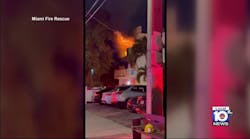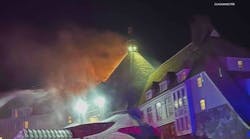TAMPA, FL: March 1, 1908 — A fire broke out at around 9 A.M. in a boarding house on Twelfth Avenue and spread quickly, fanned by high winds. Flames extended to numerous buildings, including cigar factories. Arriving firemen faced not only a growing wall of flames, but inadequate water pressure. Restaurants ignited, saloons took fire and eventually 200 dwellings were burning. The flames were finally subdued by 1 P.M., but not before destroying 308 buildings across a 55-acre area.
COLLINWOOD, OH: March 4, 1908 — At 9:30 A.M., the 325 students and their nine teachers at the Lake View School stood up from their desks in response to the fire alarm bell. Opening the classroom doors, it became immediately apparent it was not a drill as dense, hot smoke filled the hallways. The flames, starting in the basement, had already cut off most escape routes. Within moments, the school began filling with flames. Some fleeing children encountered locked exit doors and became trapped as the deadly fire swept in. Arriving volunteer firemen heard a sickening crash as the flaming interior of the building began to collapse. The fire was battled for three hours with the final death toll of 175 students. It was one of the deadliest school fires in U.S. history.
BAHIA, BRAZIL: March 13, 1908 — Reports spread that a great conflagration was raging in the business district of the capital city. Firemen were unable to handle the swelling firestorm as more than 30 buildings filled with flames. Several civilian fatalities were reported as firemen reformed their lines and reinforcements arrived.
NATCHEZ, MS: March 14, 1908 — A gas explosion tore through the basement of the five-story Natchez Drug Co., damaging the rear foundation wall enough to cause the collapse of the structure onto the adjoining brick tenement building. As the dust settled, fires sprang up in the splintered ruins. Responding firemen were faced with two collapsed structures with injured in the tenement and as many as five trapped within the burning drug building.
LYONS, FRANCE: March 15, 1908 — A nighttime fire that broke out in a large biscuit factory quickly spread to the adjoining structures. Firemen struggled with the advanced flames, but could do little to slow the spread. Within several hours, the flames were burning across 22 acres, including numerous houses.
LONDON, ENGLAND: March 25, 1908 — Flames were discovered at around 4 A.M. in the world-famous Drury Lane Theatre. The stage area and scenery were destroyed by the stubborn flames despite the excellent work of the fire brigade. The theater was first built in 1663, later burned down and was rebuilt in 1672. Fire again destroyed it in 1809; the present structure was completed in 1812.
SPRINGFIELD, MA: March 26, 1908 — With the Republican State Convention in full swing several blocks away, a fire broke out in the Leland Hotel. Numerous convention delegates rushed to the hotel to retrieve their belongings when word of the fire spread throughout the site of the event. Thirty minutes after the start of the fire, the hotel's roof collapsed onto the top floor and firemen quickly had water on the deep-seated flames. There were no injuries or loss of life, but the structure was destroyed and all of its contents were a complete loss.
PAUL HASHAGEN, a Firehouse® contributing editor, is a retired FDNY firefighter who was assigned to Rescue Company 1 in Manhattan. He is also an ex-chief of the Freeport, NY, Fire Department. Hashagen is the author of FDNY 1865-2000: Millennium Book, a history of the New York City Fire Department, and other fire service history books.





